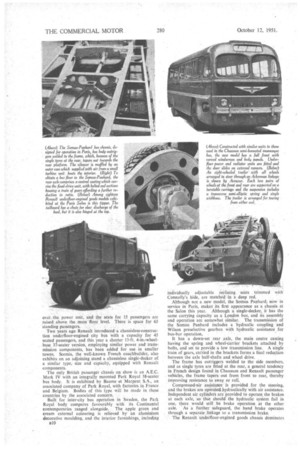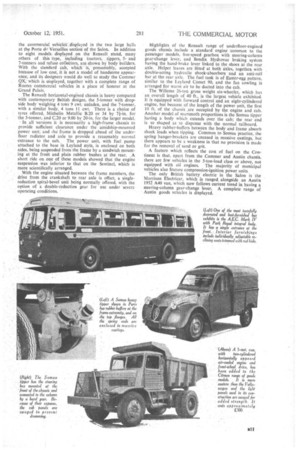France Feel ts Way signs with New I
Page 42

Page 43

Page 44

Page 45

If you've noticed an error in this article please click here to report it so we can fix it.
CROWDS at the Paris.Show are gathering round the Laftli7,kand daily to gaze at the gas turbine 10-tonner,.which;as the.designer informed us, was merely assembledfOr the .EXhibitidn. and would not "be used on the road in -itSpresent fotni. . It is" similar in construction to :a prototype,. which is alleged to be undergoing., trials, but apart from the turbine, the designer is not Satisfied. with thepresent transmission and braking arrangements.. Other new vehicles .introduced at the Paris Salon, which closes on Sunday, include Berliet and Chausson underfloor-eigined passenger. models.:. The, Chausson representative admitted that the chassis specification was not completed, the vehicle being shown to obtain the reactions of dealers and distributors, and to sound the market in general. It was claimed that a number of the Berliet underfloor-engined buses might be built for operation in Lyons.
The Laffly turbine 10-tonner shown is equipped with a single-stage compressor, running at a speed of 30,000 r.p.m., whilst the two-stage power turbine operates at 20,000 r.p.m. There is no heat-exchanger. The prototype undergoing trials has a two-stage compressor and two-stage turbine. Enclosed at the back of the B8 'turbine is a reduction gear of 10.2 to 1. connected by an open shaft to a two-speed gearbox... This gearbox is normally used in direct drive, the 3-to-I reduction ratio being necessary for starting from rest on hills when the lorry is loaded.
Unlike the conventional internal-combustion engine, there is practically no retarding force in a gas turbine when the injected fuel quantity is reduced `for deceleration. To overcome this obstacle, the Laffly has a multidisc transmission brake interconnected with . the accelerator pedal, the brake being brought into use with return movement of the pedal. This is arranged to give deceleration equivalent to the pumping loss of a conventional power-unit. The disc brake is also operated, together with the shoes at all.four. wheels,, by the brake pedal: . This transmission brake, with seven discs, is said to overheat in the Laffly chassis and the designer discussed plans for mounting a dynamometer. behind. the turbine and driving the rear wheels through twin
electric motors. .
In layout, the Laffiy has a deep air intake of frame width and situated below the front .cross-member, ducted to the 180-200 h.p.-gas turbine which is between the chassis side members and projects partly above
frame level. The prototype is said to he a 120 h.p. unit. Exhaust 'gases emerge through two large rectangularsection pipes, each being parallel to, and below, the frame main members. These pipes extend to a point midway between the aides. It is claimed that the turbine fitted can reach peak speed, frOin stalling, in five seconds and that with the existing drive ratio the vehicle can attain 60 m.p.h. on the road.
Chausson, the best-known manufacturer of monocoque-construction passenger vehicles in France, has produced a full-fronted forward-control luxury coach using similar methods and fixtures to those employed in the half-bonneted model. One of the full-fronted coaches shown bas a Hispano-Suiza six-cylindered oil engine made under licence by Hercules, of France. This
is a prototype and is placed in such a position on the stand that the side panels cannot be raised for inspection of the underfloor power unit mounted between the axles. It has a Renondin five-speed gearbox, but the manufacturer is prepared to offer a selection of power and transmission units. •
Apart from the interior furnishing, the shape at the entrance and the frontal styling, it is generally similar-to the mass-produced half-bonneted coach. The main criticism is the divided windscreen, which has several blind spots, restricting the view from the driving seat. An innovation in the driver's.door is a window divided vertically, both sections of, the frameless glass being arranged to pi%ot throUgh 90 degrees towards the driver.
Equipped with Michelin Metallic single tyres equivalent to 11.00 by 20-in.. sectidif,the"cciach has a floor height at the entrance and 'central .gangway of 2 ft. 44 ins. A slight d'orne in --the 'centre of the roof increases headroom above the• gangway. This new coach, with underfloor -PoWer• unit 'or conventional vertical engine at the front,' is luxuriously equipped for 36 passengers. It .Geighs:7,tons 6 cwt. unladen. ' .
A standard five-cylindered oil engine was modified for horizontal mounting in one of the Berliet exhibits. There is little technical information available on this model. but it is understood that, apart from alterations to the position or the fan and dynamo drive and trans..
verse mounting of the fuel-injection pump at the front of the engine, the chassis components are basically unchanged. The 7.9-litre horizontal power unit weighs approximately 16 cwt. and develops 115 b.h.p. at 2,000 r.p.m.
Advantage has been taken of the engine position to provide an exit forward of the front axle and, although such vehicle would not pass the ground-clearance conditions imposed in Britain, the, floor height at the exit is 2 ft. 3i ins. The floor is inclined towards the centre
over the power unit, and the seats for 15 passengers are raised above the main floor level. There is space for 65
'standing passengers. • . .
Two years ago Renault introduced a chassisless-construetion underfloor-engined city bus with a capacity for 45 seated passengers, and this year a shorter 13-ft. 4-in.-wheelbase 37-seater version, employing similar power and transmission components, has been added for use in smaller towns. Scemia, the well-known French coachbuilder, also exhibits on an adjoining stand a chassisless single-decker of a similar type, size and capacity, equipped with Renault components. The only British passenger chassis on show is an A.E.C. Mark IV with an integrally mounted Park Royal 38-seater bus body. It is exhibited by Baume •et Marpent S.A., an associated company of Park Royal, with factories in France and Belgium. Bodies of this type will be made ill these countries by the associated concern.
Built for inter-city bus opera.tion in Sweden, the Park Royal body compares favourably With its Continental contemporaries ranged alongside. The apple green and cream external colouring is relieved by an aluminium decorative moulding, and the interior furnishings, including B10 individually adjustable reclining seats trimmed with
Connolly's hide, are matchedin a deep red. .
Although not a new model, the Sornua Paphard;,now in service in Paris, makes its first appearance as a chassis, at the Salon this year. Although a single-decker,. it has the same carrying capacity as a London bus, and its assembly and operation are somewhat similar. The transmission of the Sornua Panhard includes a hydraulic coupling and Wilson preselective gearbox with hydraulic assistance for
bus-bar operation. .
It has a down-set rear Axle, the main centre casting having the spring and wheel-carrier brackets attached by bolts, and set to provide a low transmission line. A single train of gears, carried in the brackets forms a final reduction between the axle half-shafts and wheel drive.
The frame has outriggers welded to the side members, and as single tyres are fitted at the rear, a general tendency in French design found in Chausson and Renault passenger vehicles, the frame tapers out from front to rear, thereby improving resistance to sway or roll.
Compressed airassistance. is provided for the steering, and the brakes are operated, hydraulically with air assistance. Independent air cylinders are provided to operate the brakes at each axle, so that should the hydraulic system fail in one, there would still . be brake operation at the other axle. As a .further safeguard, the hand brake operates through a separate linkage to a transmission brake.
. The Renault briderfloor-engined goods chassis dominates
the commercial veNcles displayed in the two large halls at the Porte df.: Versailles section of the Salon, in addition to eight models displayed on the Renault stand, many others of this type, including tractors, , tippers, 5and 7-tonners and refuse collectors, are shown by body builders. With the standard cab, which is, presumably, accepted because of low cost, it is not a model of handsome appearance, and its designers would do well to study the Commer QX,which is aisplayed, together with a complete range of Rootes commercial vehicles in a place of honour at the Grand Palais.
The Renault horizontal-engined chassis is heavy compared with contemporary British designs, the 5-tonner with dropside body weighing 4 tons 9 cwt. unladen, and the 7-tonner, with a similar body, 4 tons 11 cwt. There is a choice of tyres offered, Michelin Metallic B.20 or 34 by 71-in, for the 5-tonner, and C.20 or 9.00 by 20-in, for the larger model. In all versions it is necessarily a high-frame chassis to provide sufficient clearance under the amidship-mounted power unit; and the frame is dropped ahead of the underfloor radiator and axle to provide a reasonably normal entrance to the cab. The power unit, with fuel pump attached to the base in Leyland style, is enclosed on both sides, being suspended from the frame by a sandwich mounting at the front and plain rubber bushes at the rear. A short ride on one of these models showed that the engine suspension was inferior to that on the Sentinel, which is more scientifically arranged.
With the engine situated between the frame members, the dtive from the crankshaft to rear axle is offset, a singlereduction spiral-bevel unit being normally offered, with the option of a double-reduction gear for use under severe operating• conditions. Highlights of the Renault range of underfloor-engined goods chassis include a standard engine common to the passenger models, live-speed gearbox with steering-column gear-change lever, and Bendix Hydrovac braking system having the hand-brake lever linked to the shoes at the rear axle. Helper leaves are fitted at both axles, togethes with double-acting hydraulic shock-absorbers and an anti-roll bar at the rear axle. The fuel tank is of Easter-egg pattern, similar to the Leyland Comet 90, and the fan cowling is arranged for warm air to be ducted into the cab.
The Willeme 26-ton gross weight six-wheeler, which has an overall length of 40 ft., is the largest vehicle exhibited. It is equipped with forward control and an eight-cylindered engine, but because of the length of the power unit, the first 10 ft. of the chassis ,are occupied by the engine and cab. Another model of mammoth proportions is the Somua tipper having a body which extends over the cab; the rear end is so shaped as to dispense with the normal tailboard.
Heavy rubber-buffers between the body and frame absorb shock loads when tipping. Common to Sonata practice, the spring hanger-brackets are encased in massive castings, but there appears to be a weakness in that no provision is made for the removal of sand or grit.
A feature which reflects the cost of fuel on the Continentl is that, apart from the Commer and Austin chassis, there are few vehicles in the 5-ton-load class or above, not equipped with oil engines, The majority of municipal vehicles also feature compression-ignition power units The only British battery' electric in the Salon is the Morrison Electricar, which is ranged, alongside an Austin 1952 A40 van, which now follows current trend in having a steering-column gear-change lever. A complete range of Austin goods vehicles is displayed.




















































































